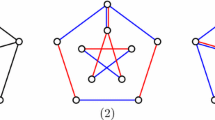Abstract
This paper concerns a domination problem in graphs with parity constraints. The task is to find a subset of the vertices with minimum cost such that for every vertex the number of chosen vertices in its neighbourhood has a prespecified parity. This problem is known to be \({\mathcal NP}\) -hard for general graphs. A linear time algorithm was developed for series-parallel graphs and trees with unit cost and restricted to closed neighbourhoods. We present a linear time algorithm for the parity domination problem with open and closed neighbourhoods and arbitrary cost functions on graphs with bounded treewidth and distance-hereditary graphs.
Similar content being viewed by others
References
Amin A and Slater P (1992). Neighborhood domination with parity restriction in graphs. Congr Numer 91: 19–30
Arnborg S, Lagergren J and Seese D (1991). Easy problems for tree-decomposable graphs. J Algorithms 12: 308–340
Balasundaram B and Butenko S (2006). Graph domination, coloring and cliques in telecommunications. In: Resende, MGC and Pardalos, PM (eds) Handbook of optimization in telecommunications, pp 865–890. Springer Science + Business Media, New York
Bandelt H-J and Mulder HM (1986). Distance-hereditary graphs. J Comb Theory Ser B 41: 182–208
Bodlaender H (1993). A tourist guide through treewidth. Acta Cybern 11: 1–21
Broersma HJ, Dahlhaus E and Kloks T (2000). A linear time algorithm for minimum fill-in and treewidth for distance hereditary graphs. Discret Appl Math 99: 367–400
Caro Y and Jacobson M (2003). On non-zero (mod k) dominating sets. Discuss Math Graph Theory 23: 189–199
Chang MS, Wu SC, Chang GJ and Yeh HG (2002). Domination in distance-hereditary graphs. Discret Appl Math 116: 103–113
Cogis O and Thierry E (2005). Computing maximum stable sets for distance-hereditary graphs. Discret Optim 2: 185–188
Courcelle B (1990). The monadic second-order logic of graphs. I. Recognizable sets of finite graphs. Inf Comput 85: 12–75
Damiand G, Habib M and Paul C (2001). A simple paradigm for graph recognition: application to cographs and distance hereditary graphs. Theor Comput Sci 263: 99–111
D’Atri A and Moscarini M (1988). Distance-hereditary graphs, Steiner trees and connected domination. SIAM J Comput 17: 521–538
Dawes R (1989). Minimum odd neighbourhood covers for trees. Lect Notes Comput Sci 507: 161–169
Goldwasser J and Klostermeyer W (2002). Maximization versions of “Lights Out” games in grids and graphs. Congr Numer 126: 99–111
Hammer PL and Maffray F (1990). Completely separable graphs. Discret Appl Math 27: 85–99
Hatzl J, Wagner S (2008) Combinatorial properties of a general domination problem with parity constraints. Discret Math (2008). doi:10.1016/j.disc.2007.12.005
Haynes T, Hedetniemi S and Slater P (1998). Fundamental of Domination in Graphs. Marcel Dekker, New York
Howorka E (1977). A characterization of distance-hereditary graphs. Quart J Math Oxford Ser 2(28): 417–420
Hsieh SY, Ho CW, Hsu TS and Ko MT (2006). The hamiltonian problem on distance-hereditary graphs. Discret Appl Math 154: 508–524
Kao M and Liao C (2007). Capacitated domination problem. Lect Notes Comput Sci 4835: 256–267
Kelleher LL and Cozzens MB (1988). Dominating sets in social networks. Math Soc Sci 16: 267–279
Robertson N and Seymour PD (1986). Graph minors II. Algorithmic aspects of tree-width. J Algorithms 7: 309–322
Sutner K (1989). Linear cellular automata and the garden of Eden. Math Intell 11(2): 49–53
Yeh HG and Chang GJ (2003). Centers and medians of distance-hereditary graphs. Discret Math 265: 297–310
Author information
Authors and Affiliations
Corresponding author
Additional information
This research is partially supported by the Austrian Science Fund Project P18918-N18 Efficiently solvable variants of location problems.
Rights and permissions
About this article
Cite this article
Gassner, E., Hatzl, J. A parity domination problem in graphs with bounded treewidth and distance-hereditary graphs. Computing 82, 171–187 (2008). https://doi.org/10.1007/s00607-008-0005-8
Received:
Accepted:
Published:
Issue Date:
DOI: https://doi.org/10.1007/s00607-008-0005-8




